Do-it-yourself hunting knives
by Keith Spencer
Hunter 2
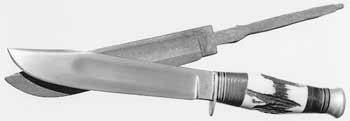 More knife users are becoming less intimidated by the prospect of making their own hunting knives. But why bother when there are so many knife styles, shapes and sizes so readily on offer in the marketplace? The short answer is because you can, which is probably the reason why people embark upon most projects. In the case of sporting bladeware, do-it-yourself knives give you what you want and are personalised.
More knife users are becoming less intimidated by the prospect of making their own hunting knives. But why bother when there are so many knife styles, shapes and sizes so readily on offer in the marketplace? The short answer is because you can, which is probably the reason why people embark upon most projects. In the case of sporting bladeware, do-it-yourself knives give you what you want and are personalised.
Your choice in a personalised knife can be achieved one of three ways: restoration of a knife already in service, customisation of a new or old knife blank or custom crafting a knife from scratch. It’s a matter of which you feel the most comfortable doing. Once a workstation is set up, you will probably find yourself doing a bit of it all.
The good news is you don’t need a workplace decked-out with sophisticated equipment. Basically, you need a bench with a vice and a bunch of hand tools - files, hacksaw, drill and drill-bits, wet and dry sheets in various grits, small nylon and brass cleaning brushes and fine to coarse Scotchbrite pads. Many of the small tools and jigs can be easily made as aids to restoration and customisation - improvisation. Throughout a period of time, knife restorers, customisers and makers accumulate all kinds of knick-knacks invented and made to perform tasks more efficiently and safely.
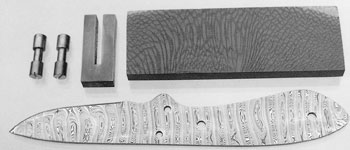 Although you can ply the craft without throwing a switch, an eight-inch bench grinder with a belt-grinding attachment and mitre table is a sound investment in your workshop. Compact and versatile, such a machine is worth budgeting for and, compared to specially made knifemaker’s machines priced from $1200 to $3000, it is very affordable at less than $600. Once installed, the machine can be used for all sorts of tasks, leaving you wondering how you managed to live without it.
Although you can ply the craft without throwing a switch, an eight-inch bench grinder with a belt-grinding attachment and mitre table is a sound investment in your workshop. Compact and versatile, such a machine is worth budgeting for and, compared to specially made knifemaker’s machines priced from $1200 to $3000, it is very affordable at less than $600. Once installed, the machine can be used for all sorts of tasks, leaving you wondering how you managed to live without it.
Make sure though, that the belt-grinding attachment has an eight-inch diameter contact wheel to enable you to hollow-grind any knives you make or customise. It should also have a platen to surface grind and a disc for end squaring. A mitre table attached to the disc section sets angles for grinding. This multi-functional device is attached to one end of the bench grinder. To the opposite end can be attached a wire brush, polishing buff or grinding wheel. Machines can quickly remove bulk material and basically shape knife blanks, grips guards and pommels, rendering them ready for bench finishing by hand. Some knifemakers almost entirely make and finish their knives using machines; however, the finished product can hardly be said to be handmade.
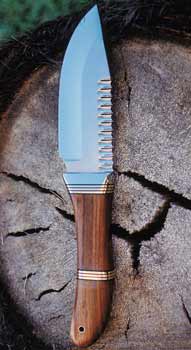 A few hours spent at the workbench restoring, customising and/or hand-making edged tools can be a very absorbing and satisfying pastime - a great way to temporarily forget the worries of the world. When you feel a bit edgy (pardon the pun), consign yourself to the workshop for an afternoon of knife work. It works for me and at the end of the day, maybe an old knife has been re-activated or a new one pressed into service. Too many edged tools are never enough for those who understand the ethos of knives.
A few hours spent at the workbench restoring, customising and/or hand-making edged tools can be a very absorbing and satisfying pastime - a great way to temporarily forget the worries of the world. When you feel a bit edgy (pardon the pun), consign yourself to the workshop for an afternoon of knife work. It works for me and at the end of the day, maybe an old knife has been re-activated or a new one pressed into service. Too many edged tools are never enough for those who understand the ethos of knives.
Obviously, restoration relates to repairing and returning a knife more or less to its original condition. In the life of a well-worked knife, the blade will probably outlive a handle or two, unless the grip is fashioned from strongly secured, indestructible material. Blades too, suffer from the ravages of hard work (and sometimes abuse) throughout many years. There is something special about salvaging an old knife from the scrap heap that still has life left in the blade. In some instances knives have historic value as collectable artefacts, in which case they require special attention lest they lose their value.
Don’t be surprised to find among the thousands of pre-owned knives scattered around the nation hunting knife styles that manufacturers once produced that you find appealing. Perhaps the ‘oldie but goody’ has a few character lines - scratches, dents and tarnish spots and maybe the handle is a bit rickety (cosmetic problems) - but nothing that can’t be tidied up using workbench skills and a measure of tender love and care. A few hours work and, hey presto, a personalised piece for your next hunting trip.
Knife customisation can be one of two things, building a knife from a finished or semi-finished blank or re-constituting an existing knife to suit the user’s needs. An example of the latter is to cut off part of a bayonet blade then reshape what is left attached to the handle. Customisation is a popular way for knifemakers to get started because the process enables them to get hands-on existing knife designs before embarking upon drawing up their own designs.
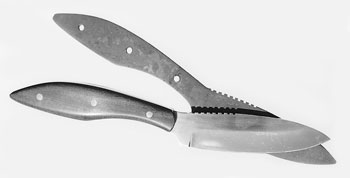 Unfinished blanks are generally those that have only been forged-to-shape and still in blackened condition with shale on the surface. The benefit of this type of knife blank, in addition to being pre-shaped, is that the blade bevel has been compacted for extra strength under the hammer. The degree of difficulty is greater when customising from a forged-to-shape blank compared to customising a finished knife blank that only requires accoutrements to be fitted (grip, guard, etc). Finished blades are already heat treated, whereas rough-forged blanks usually need to be annealed to work on, then hardened and tempered when completed.
Unfinished blanks are generally those that have only been forged-to-shape and still in blackened condition with shale on the surface. The benefit of this type of knife blank, in addition to being pre-shaped, is that the blade bevel has been compacted for extra strength under the hammer. The degree of difficulty is greater when customising from a forged-to-shape blank compared to customising a finished knife blank that only requires accoutrements to be fitted (grip, guard, etc). Finished blades are already heat treated, whereas rough-forged blanks usually need to be annealed to work on, then hardened and tempered when completed.
Rough-forged knife blanks are tool steel (01 carbon) and easy enough to heat-treat by the customiser armed with a technical sheet. Customisers preferring stainless blades opt for finished blades that are already heat-treated. Few knifemakers heat treat blades made from stainless steel bar stock because of the difficulties involved and utilise the services of professional heat-treating firms. Many hunters prefer skinning, boning and utility knives made from tool steel (01 carbon), believing they cut more efficiently and re-sharpen more easily. However, unlike knives made from stainless steel, those fashioned from tool steel will tarnish and eventually corrode if the user fails to keep them clean and oiled. Still, it is good practice to properly maintain all your hunting equipment so that it is always ready to go at short notice.
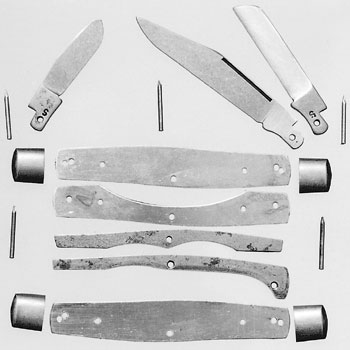 Personal preference determines the knife steel used, but opinions ought to be based upon fair and equitable tests of stainless and carbon steels. For example, the two most popular steels are 440C stainless steel and K460 (Bohler code) 01 carbon steel. A true test involves making identical knives from each steel (say a drop-point hunter), heat treat them to the same Rockwell Hardness (say 56RC), then subject both knives to exactly the same controlled tests. Tests should be about cutting efficiency, edge holding and ease of re-sharpening. Your opinion may (or may not) change, but under these conditions both steels have an equal opportunity to demonstrate their ability to perform.
Personal preference determines the knife steel used, but opinions ought to be based upon fair and equitable tests of stainless and carbon steels. For example, the two most popular steels are 440C stainless steel and K460 (Bohler code) 01 carbon steel. A true test involves making identical knives from each steel (say a drop-point hunter), heat treat them to the same Rockwell Hardness (say 56RC), then subject both knives to exactly the same controlled tests. Tests should be about cutting efficiency, edge holding and ease of re-sharpening. Your opinion may (or may not) change, but under these conditions both steels have an equal opportunity to demonstrate their ability to perform.
Handcrafting your own hunting knife is a valid proposition. You don’t need any machines, only a workbench, vice and hand tools. Most of the older knifemakers fashioned their first knives entirely with hand tools - no switches thrown. If you have field-dressed game and gilled and gutted fish, then you know a lot about how knives work - or how they are supposed to work, which is the main reason for contemplating making your own edgeware. You know the blade you like, how the grip should feel and the sorts of tasks expected of a good hunting knife - and wouldn’t it be great to use the knife you designed and made for yourself?
If doing it yourself is the way you choose to go, assemble all you know on a piece of paper, study the factory-made hunting knives on the market, then read a book on knifemaking. Commit your design ideas to paper and during a period of time sketch scores of shapes and styles until you arrive at the drawing that best represents what you want to make. Set about making the knife, but don’t be in a hurry. Using hand files can be a slow process. Good. The slower you proceed, the more character you can factor into the knife concept in your hands. Think, work, check and refine - that’s what creating a personal knife is all about. Be careful and get it right. Books, videos and knifemaking supplies are available in Australia, as well as lots of good advice.
Captions
Image 1: Forged-to-shape large hunting knife factory-made in Sheffield, England.
Image 2: Hunting knife blank fashioned from Damasteel (Swedish stainless Damascus) ready for the grip and guard to be fitted.
Image 3: Heavy-duty handcrafted hunting knife by budding knifemaker Peter Cocks of Kalgoorlie in the western goldfields.
Image 4: A small hunting knife customised from Solingen, Germany, forged-to-shape blank.
Image 5: Three-blade stockman pocketknife kit available in kit form for customisers.
